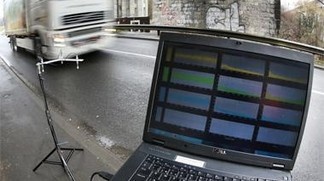Bimodal sound source tracking applied to road traffic monitoring (start: 2008 - end: 2013)

Today, the heterogeneity of the available data makes their processing complex and expensive (multiple sensors with different technologies, placed in different locations, with their own data format, unsynchronized, etc.). This leads metrologists to develop “smarter”monitoring devices, i.e.capable of providing all the necessary data synchronized from a single measurement point, with no impact on the flow road itself and ideally without complex installation.
This work contributes to achieve such an objective through the development of a passive, compact, non-intrusive, acoustic-based system composed of a microphone array with a few number of elements placed on the roadside. The proposed signal processing techniques enable vehicle detection, the estimation of their speed as well as the estimation of their wheelbase length as they pass by. Sound sources emitted by tyre/road interactions are localized using generalized cross-correlation functions between sensor pairs. These successive correlation measurements are filtered using a sequential Monte Carlo method (particle filter) enabling, on one hand, the simultaneous tracking of multiple vehicles (that follow or pass each other) and on the other hand, a discrimination between useful sound sources and interfering noises.
This document focuses on two-axle road vehicles only. The two tyre/road interactions (front and rear) observed by a microphone array on the roadside are modeled as two stochastic, zero-mean and uncorrelated processes, spatially disjoint by the wheelbase length. This bimodal sound source model defines a specific particle filter, called bimodal
particle filter, which is presented here. Compared to the classical (unimodal) particle filter, a better robustness for speed estimation is achieved especially in cases of harsh observation. Moreover the proposed algorithm enables the wheelbase length estimation through purely passive acoustic measurement. An innovative microphone array design methodology, based on a mathematical expression of the observation and the tracking methodology itself is also presented.
The developed algorithms are validated and assessed through in-situ measurements. Estimates provided by the acoustical signal processing are compared with standard radar measurements and confronted to video monitoring images. Although presented in a purely road-related applied context, we feel that the developed methodologies can be, at
least partly, applied to rail, aerial, underwater or industrial metrology.